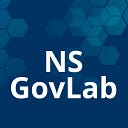by Natasha Halili-Banks, Communications Assistant
To kick off things for our first group of Fellows NS GovLab held a three-day session of learning, practicing and experimenting. The gathering took place at White Point Lodge, the perfect place to reflect, re-charge and find inspiration.
What was the purpose of this gathering?
- Get to know each other
- Lab 101. Build a foundation of understanding of what NS GovLab is and why we are coming together to work in this way
- Share experiences and understand the context of the aging population in Nova Scotia and what that means for different people
- Team selection. Develop the initial “How Might We” questions
Day 1
The first part of the day was focused on Fellows getting to know each other and the co-creation team. The co-creation team is responsible for designing, facilitating, and evaluating NS GovLab’s initiatives and activities.
Everyone participated in a few creative activities to break the ice, one of which involved creating a personal bunting flag. At the end of the day flags were hung up, representing the wonderful collective in the room.
The second part of the day saw the introduction of the social innovation lab model. What is a Lab? and Why are we using a Lab? These questions were explored and documented with the fantastic graphic recording of Brave Space.
For the last part of the day, the co-creation team presented a snapshot of provincial and municipal data profiles. This provided the Fellows with an overview of the distribution of demographics in the province. Building on this overview, the Fellows participated in a group exercise to identify assumptions about the aging population. They then compared those assumptions against the data profiles.
Day 2
Everyone hit the ground running on day two, with the introduction of leadership principles (check back for an in-depth blog post on this!). Once again, the artistic talents of Brave Space captured the essence of the discussion in a graphic recording.
The group then moved on to an exercise which required them to consider a few important questions:
When it comes to an aging population, what is necessary for the worst-case scenario to happen?
How are our actions contributing to a worst case scenario?
How can we make space for new thinking and experimentation?
What can we stop doing or do differently?
Groups used scenario analysis to help them map out new opportunities for creative investigation.
To break up the day and work in some movement, fellows took part in a noticing exercise. They were encouraged to take time and space to observe their surroundings, notice their thoughts and then, redirect their attention back to present. Fellows were encouraged to share their observations.
The goal of this exercise is to understand that each person sees the world differently and our collective strength comes from hearing and understanding each other’s perspective
The afternoon continued with some open space technology, with fellows reflecting on concepts most important to them and exploring their potential areas of interest.
This participant driven exercise invited fellows to co-create an agenda and share their passion. It’s a critical step that allowed people to move into action quickly on day three and take responsibility for their chosen topic.
Like any good Monday night, the evening capped off with an impromptu lyre concert and a karaoke sing along. Many of the famous White Point bunnies were seen scurrying towards the lodge to hear the melodic tunes wafting out of the building.
Day 3
The final day began with a workshop introduction on human centered design. The fellows learned about this creative approach to problem solving and how the human perspective is an important tool to utilize when looking at adapting and changing systems.
Building on the open space discussions from day two and the focus of day three on human centered design, fellows established teams and formulated their initial “How Might We” questions.
The four “How Might We” questions the teams identified were:
· How might we address isolation through inter-generational connection and creativity?
· How might we understand the kinds of supports needed to age-in place?
· How might we evaluate if and how some can remain in their home as they age?
· How might we develop an intergenerational ecosystem where social innovation is learned and practiced?
Inspired by the questions they developed, teams were ready to begin developing research plans for the inspiration phase of NS GovLab
… and off into the world they went!
Next up
Teams are currently collecting information and working within their communities to explore their How Might We questions.
Their research will help them:
· Gain multiple perspectives from a broad cross-section of people
· Deepen their understanding of the issue(s)
· Test their assumptions
NS GovLab is ready and excited to share all our developments with you…stay tuned for more blog posts. For more updates, follow us on Twitter
